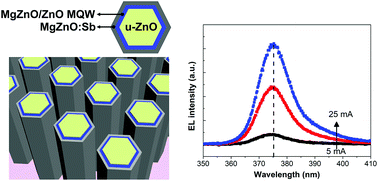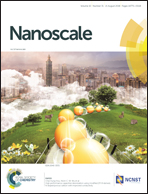Radial multi-quantum well ZnO nanorod arrays for nanoscale ultraviolet light-emitting diodes†
Abstract
Since semiconducting ZnO has attractive properties such as wide bandgap and large exciton binding energy, it has motivated us to realize efficient ultraviolet (UV) light-emitting diodes (LEDs). Furthermore, facile growth of ZnO nanostructures has triggered numerous research studies to examine them as nanoscale building blocks for optoelectronic devices. Here, we demonstrate the growth of ZnO-based core–shell p–n homojunction nanorod arrays with radial MgZnO/ZnO multiple quantum wells (MQWs) and report the characteristics of a core–shell ZnO nanorod LED. The shell layers of MgZnO/ZnO MQWs and p-type antimony-doped MgZnO were epitaxially grown on the surface of ZnO core nanorod arrays. By introducing the radial MQWs, the photoluminescence intensity was greatly increased by 4 times, compared to that of the bare ZnO nanorod array, suggesting that the core–shell MQWs can be used to realize the nanoscale ZnO LEDs with high internal quantum efficiency. As the injection current increased, the EL intensity of UV emission at 375 nm from the MgZnO/ZnO MQWs strongly increased without shifting of the emission peak because of the non-polar nature of MQWs grown on the side walls of the ZnO nanorods. These results highlight the potential of an integrated nanoscale UV light emitter in various photonic devices.



 Please wait while we load your content...
Please wait while we load your content...